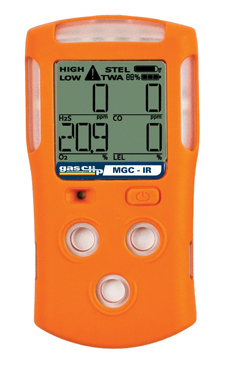Calibration and Testing for Accurate Readings
Direct-Reading Portable Gas Monitors (DRPGM’s) are an essential piece of equipment which is specifically designed to alert workers to the presence of toxic gases.
It shouldn’t need much emphasis on how important a portable gas detector is to the safety of workers and it is equally important to ensure that this equipment is correctly calibrated and regularly tested for accuracy.
Meeting OSHA guidelines
The Occupational Safety and Health Administration (OSHA) have some clear guidelines on direct-reading instruments and the role they have to play in keeping workers as safe as possible.
In an industrial setting or anywhere where workers are potentially exposed to the dangers of gases, vapors, aerosols and fine particles suspended in air, these instruments are needed to provide real-time data if possible, which is accurate and allows someone working in that environment to evaluate the level of air contaminants and the level of risk.
All workers have a right to enjoy a safe workplace and the use of direct-reading instruments helps achieve this particular goal.
Bump testing
It is not understating the situation to state that gas detection instruments offer life-saving protection, but they need to be in full working order and accurate in order to fulfil their duty.
The only comprehensive way to verify that the detection equipment is performing properly and the alarm operation and sensor are working correctly, is to perform a bump test.
What bump testing involves is to briefly expose the installed sensors to a controlled concentration of calibrations gas that is higher than the predetermined low alarm set point. You might also hear the bump test being referred to as a functional test and it is important to note that the test is specifically designed to test that the sensor and alarm are working correctly.
This means that bump testing is not used to measure the accuracy of the sensor and no instrumentation adjustments are made during the testing process.
Calibration
The fundamental reason why regular calibration is necessary is due the fact all sensors will gradually degrade over a period of time and this can lead to inaccurate sensor readings.
The calibration process involves allowing the instrument to self-adjust until it continues to retain an ability to produce accurate measurements and therefore subsequently displays the true gas concentration values that you are dealing with.
The calibration test will fail equipment where the sensor has degraded below the required level and it is a clear indication that a sensor is no longer fit for purpose and needs to be replaced.
Setting to zero
The process of zeroing is about setting each installed sensor to the point where it is able to recognize the ambient air as clean air.
The relevance of zeroing is that if the ambient air is not completely clean air, any gasses that are actually present and can be detected by the sensor equipment being used, will be measured and displayed as zero.
These inaccurate readings could create a hazardous environment, which is why the unit has to be correctly zeroed.
Reset the peak readings
Each instrument will normally automatically store the highest detected gas reading that it has found and what you may find is that when you perform bump testing and calibration, the peak reading may well be adjusted to register this new level.
The operator should reset the peak readings after the test has been completed and also when they take the instrument to a new location or after an alarm activation.
Clearing these peak readings should not affect the machine’s data log which maintains a record of all events so that in the event of an incident or investigation, the history of testing and reading results can still be recalled.
Regular testing
The key to ensuring good worker safety is regular testing and calibration for example, should be done before the unit is first used and then on a monthly basis thereafter.
You can also schedule in bump testing in-between your regular monthly calibrations.
Portable multi gas detectors should be an integral part of your overall safety guidelines that you will be working to in the workplace at all times in order to keep everyone working there as safe as possible.
Regular testing of DRPGM’s and educating workers about the potential hazards they may become exposed to and how to deal with an emergency situation, should be part of your company policy.
It is also critical to note the importance of not just having the right testing equipment but also making sure that the readings are accurate through regular calibration and maintenance.
Find a Home-Based Business to Start-Up >>> Hundreds of Business Listings.

















































